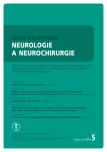The best approach in motorized Parkinson‘s disease therapy is APOMORPHINE INFUSION
Published in:
Cesk Slov Neurol N 2018; 81(5): 516
Category:
Controversions
Sources
1. Hughes AJ, Daniel SE, Ben-Shlomo Y et al. The accuracy of diagnosis of parkinsonian syndromes in a specialist movement disorder service. Brain 2002; 125(Pt 4): 861 – 870.
2. Volkmann J, Albanese A, Antonini A et al. Select ing deep brain stimulation or infusion ther apies in advanced Parkinson’s dis ease: an evidence-based review. J Neurol 2013; 260(11): 2701 – 2714.
3. García Ruiz PJ, Sesar Ignacio A, Ares-Pensado B et al. Efficacy of long term subcutaneous apomorphine infusion in advanced Parkinson’s dis ease with motor fluctuations: a multicenter study. Mov Disord 2008; 23(8): 1130 – 1136.
4. Mensikova K, Kaiserova M, Vastik M et al. Treatment of camptocormia with continuous subcutaneous infusions of apomorphine: 1-year prospective pilot study. J Neural Transm 2015; 122(6): 835 – 839.
5. Borgemeester RW, Lees AJ, van Laar T. Parkinson’s disease, visual hal lucinations and apomorphine: A review of the available evidence. Parkinsonism Relat Disord 2016; 27 : 35 – 40.
6. Borgemeester RW, van Laar T. Continuous subcutaneous apomorphine infusion in Parkinson’s dis ease patients with cognitive dysfunction: a retrospective longterm follow-up study. Parkinsonism Relat Disord 2017; 45 : 33 – 38.
7. Yarnall AJ, Lashley T, L ing H et al. Apomorphine: a potential modifier of amyloid deposition in Parkinson’s disease? Mov Disord 2016; 31(5): 668 – 675.
Labels
Paediatric neurology Neurosurgery NeurologyArticle was published in
Czech and Slovak Neurology and Neurosurgery

2018 Issue 5
Most read in this issue
- New insights in the diagnosis and treatment of amyotrophic lateral sclerosis
- Review of diseases with restricted diffusion on magnetic resonance imaging of the brain
- Cervical vertigo – fiction or reality?
- Anaesthesia and neuromuscular disorders
